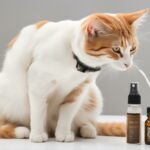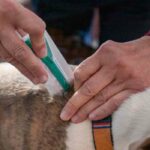As pet owners, we all want to keep our furry friends healthy and happy. Maintaining good pet hygiene is essential for their well-being. However, when it comes to bathing after flea treatment, there are a few things to consider. Applying flea treatment is an important step in preventing and controlling flea infestations. But, is it safe to bathe your pet immediately after applying flea treatment?
In this section, we will discuss the optimal time frame for bathing your pet after applying flea treatment. We will also provide you with some general guidelines to follow and highlight some common mistakes to avoid to ensure the effectiveness of the flea treatment.
Key Takeaways:
- Flea treatment plays a critical role in controlling and preventing flea infestations.
- Bathing your pet immediately after applying flea treatment can compromise the effectiveness of the treatment.
- It is important to strike a balance between flea control and maintaining good pet hygiene.
Understanding Flea Treatment Products
Before we dive into the optimal time frame for bathing after flea treatment, let’s take a closer look at the different types of flea treatment products available to pet owners. Understanding the different options will help you make an informed decision about which product is most suitable for your furry friend.
Types of Flea Treatment
There are several types of flea treatment products available, including:
| Type of Flea Treatment | Description |
|---|---|
| Topical treatments | Applied directly onto the pet’s skin, often between the shoulder blades |
| Oral medications | Taken orally by the pet, typically in the form of a chewable tablet or soft chew |
| Flea collars | Worn around the pet’s neck, usually containing a flea-repelling chemical |
It’s important to note that not all flea treatment products are created equal. Some flea treatments only kill adult fleas, while others also target flea eggs, larvae, and pupae. Additionally, certain flea treatments may be more effective against certain types of fleas or in specific environments. Consulting with a veterinarian can help you determine which flea treatment product is best for your pet’s individual needs.
Now that we have a better understanding of the types of flea treatment products available, we can move on to discussing the optimal time frame for bathing after flea treatment.
How Do Flea Treatments Work?
Understanding the mechanism of action of flea treatments can help you determine the optimal time frame for bathing your pet after application. Flea treatments work in different ways depending on the active ingredients.
Topical flea treatments are applied to the skin and coat of your pet. They work by spreading over the surface of the skin and hair, killing fleas and preventing new infestations. Some treatments contain ingredients that repel fleas, preventing them from even landing on your pet.
Oral flea treatments, on the other hand, are ingested by your pet. The active ingredients are then distributed throughout the bloodstream, killing fleas when they bite your pet. Some oral flea treatments also contain ingredients that prevent flea eggs from hatching.
One type of flea treatment that is becoming more popular is the use of flea collars. These collars release chemicals that repel and kill fleas. They work by releasing the chemicals slowly over time, and are effective for several months before they need to be replaced.
It is important to follow the instructions provided with the flea treatment product, as the mechanism of action may differ depending on the product. In general, it is recommended to wait at least 48 hours after applying flea treatment before bathing your pet to ensure that the treatment has had enough time to be fully absorbed and take effect.
Guidelines for Bathing After Flea Treatment
When it comes to bathing your pet after applying flea treatment, there are some general guidelines that you should follow to ensure the treatment remains effective. Here are some key points to keep in mind:
- Wait at least 24 hours: It’s important to allow enough time for the treatment to absorb into your pet’s skin and coat before bathing. Waiting at least 24 hours is a good rule of thumb, but make sure to check the product label for specific instructions.
- Use a mild shampoo: When you do bathe your pet, make sure to use a mild shampoo that is specifically formulated for pets. Avoid using human shampoos or harsh chemicals that could irritate your pet’s skin or wash away the flea treatment.
- Rinse thoroughly: Rinse your pet thoroughly to make sure all shampoo and flea treatment residue is removed. Leftover residue could cause skin irritation or reduce the effectiveness of future flea treatments.
- Limit baths: While regular bathing is important for maintaining your pet’s hygiene, excessive bathing can strip their coat of natural oils and reduce the effectiveness of flea treatments. Limit baths to once a month or less, unless your pet gets particularly dirty or smelly.
Following these guidelines will help ensure that your pet stays clean and flea-free without compromising the effectiveness of flea treatments. Always consult with your veterinarian if you have any questions or concerns about bathing your pet after flea treatment.
Factors to Consider
While there is no fixed rule for when to bathe your pet after flea treatment, certain factors can affect the ideal time frame. These include:
- The type of flea treatment product: Some flea treatment products require that you wait a specific amount of time before bathing your pet to ensure that the treatment has properly absorbed into the skin.
- The severity of flea infestation: If your pet has a severe flea infestation, it is best to wait a little longer before bathing to allow the treatment to take full effect.
- Pet’s behavior and preferences: Some pets may be uncomfortable or anxious after flea treatment, so it is best to avoid bathing them immediately after application.
- Pet’s overall health and skin condition: If your pet has sensitive skin or any existing skin conditions, it is best to consult with your veterinarian to determine the safest time frame for bathing after flea treatment.
By considering these factors, you can determine the optimal time frame for bathing your pet after flea treatment. It is important to prioritize both flea control and pet hygiene to ensure your furry friend stays clean and protected.
Common Mistakes to Avoid When Bathing Your Pet After Flea Treatment
As a professional copywriting journalist, I have seen many pet owners make mistakes when it comes to bathing their pets after flea treatment. Here are some common mistakes to avoid:
- Skipping the bathing step altogether: Some pet owners assume that flea treatment alone is enough to eliminate fleas and skip the bathing step. However, bathing your pet before flea treatment helps to remove any dirt or debris that may impede the effectiveness of the treatment. Similarly, bathing your pet after flea treatment helps to remove any dead fleas and their eggs, minimizing the risk of reinfestation.
- Bathing too soon after treatment: While it may be tempting to bathe your pet immediately after flea treatment, this can wash away the treatment and compromise its effectiveness. It is recommended to wait at least 48 hours before bathing your pet after applying flea treatment.
- Using the wrong shampoo: Some pet owners may assume that any shampoo would do when bathing their pets after flea treatment. However, certain shampoos contain ingredients that can neutralize the flea treatment. It is important to use a shampoo that is recommended by your veterinarian or one that is labeled as safe for use with flea treatment products.
- Not following the instructions on the flea treatment product: Different flea treatment products have different instructions for use, including the optimal time frame for bathing after application. It is important to read and follow the instructions on the product label to ensure the treatment remains effective.
By avoiding these common mistakes, you can ensure that your pet remains protected from fleas while maintaining good pet hygiene.
Alternatives to Traditional Bathing
While bathing your pet after applying flea treatment is important for maintaining good hygiene, there are alternative methods that can help in between baths. These alternatives can be especially useful if you’re concerned about bathing your pet too soon after applying flea treatment, as they won’t compromise the effectiveness of the treatment.
Dry shampoo: Dry shampoo is a great alternative to traditional bathing, particularly for cats who may not enjoy water. Simply spray the dry shampoo onto your pet’s fur, let it sit for a few minutes, and then brush it out. Not only does this keep your pet looking and smelling fresh, but it also helps in eliminating fleas.
Wet wipes: Wet wipes designed for pets are another great alternative to traditional bathing. These wipes can be used on all parts of your pet’s body, including paws, underbelly and around the face. They are especially useful for quick clean-ups after outdoor activities, or to remove dirt and debris in between baths. Make sure to choose wipes that are specifically formulated for pets to avoid irritation or allergic reactions.
Bath-free sprays: There are several bath-free sprays that can help refresh your pet’s coat and eliminate fleas. These sprays usually contain natural ingredients like lemon, eucalyptus, and cedar oil that help repel fleas and ticks. They’re easy to apply and won’t leave your pet feeling greasy or sticky.
Flea comb: Finally, a flea comb is an excellent tool for removing fleas and eggs from your pet’s fur. It’s also a great way to bond with your furry friend while maintaining their hygiene. Simply comb through your pet’s fur, making sure to reach all areas of the body, and then dispose of any fleas or eggs that you find.
By using these alternatives to traditional bathing, you can maintain your pet’s hygiene without compromising the effectiveness of flea treatment. Just be sure to follow any instructions on the product packaging, and consult with your veterinarian if you have any concerns about which alternative method is best for your pet.
Conclusion
Ensuring the proper timing for bathing your pet after flea treatment is important for both flea control and maintaining your pet’s hygiene. By understanding the different types of flea treatment products and how they work, you can make informed decisions about which product is suitable for your pet.
General guidelines for bathing after flea treatment can help to maintain the effectiveness of the treatment while keeping your pet clean. Factors such as the type of product used, the severity of the flea infestation, and your pet’s overall health should be taken into consideration when deciding on the timing of bathing.
Remember to Avoid Common Mistakes
It’s important to avoid common mistakes such as bathing your pet too soon after applying flea treatment or using the wrong type of shampoo, as this can compromise the effectiveness of the treatment. Additionally, consider alternative methods of maintaining your pet’s hygiene if you are concerned about traditional bathing.
Remember to prioritize both flea control and pet hygiene when determining the optimal time frame for bathing your furry friend after flea treatment. By following these guidelines, you can ensure the well-being of your pet while effectively managing flea infestations.
FAQ
Q: How long should I wait to bathe my pet after putting on flea treatment?
A: It is recommended to wait at least 24-48 hours before bathing your pet after applying flea treatment. This allows the treatment to fully absorb into your pet’s skin and ensures its effectiveness.
Q: What are the different types of flea treatment products available?
A: There are various types of flea treatment products available, including topical treatments, oral medication, flea collars, and flea shampoos. Each product works differently to eliminate and control fleas.
Q: How do flea treatments work?
A: Flea treatments work by either killing adult fleas, preventing flea eggs from hatching, or disrupting the flea life cycle. They typically contain active ingredients that target fleas specifically.
Q: What guidelines should I follow when bathing my pet after flea treatment?
A: When bathing your pet after flea treatment, it is important to use a mild pet shampoo and avoid abrasive scrubbing. Ensure that the treatment has had enough time to work (24-48 hours) and use lukewarm water for the bath.
Q: What factors should I consider when determining the timing of bathing after flea treatment?
A: Factors such as the specific flea treatment used, your pet’s susceptibility to fleas, and the severity of the infestation should be considered. Consulting with your veterinarian can help determine the best time frame for bathing after flea treatment.
Q: What are some common mistakes to avoid when bathing after flea treatment?
A: Common mistakes include bathing too soon after applying flea treatment, using harsh shampoos or chemicals that can interfere with the treatment, and not following the instructions provided by the manufacturer or veterinarian.
Q: Are there alternatives to traditional bathing after flea treatment?
A: Yes, there are alternatives such as dry shampoos, wipes, or spot-on treatments that can help maintain your pet’s hygiene without the need for traditional bathing immediately after flea treatment.
- Does Flea Treatment Kill Lice? - September 8, 2023
- Does Flea Treatment Kill Mites? - September 8, 2023
- How to Put Flea Treatment on a Dog? - September 8, 2023






